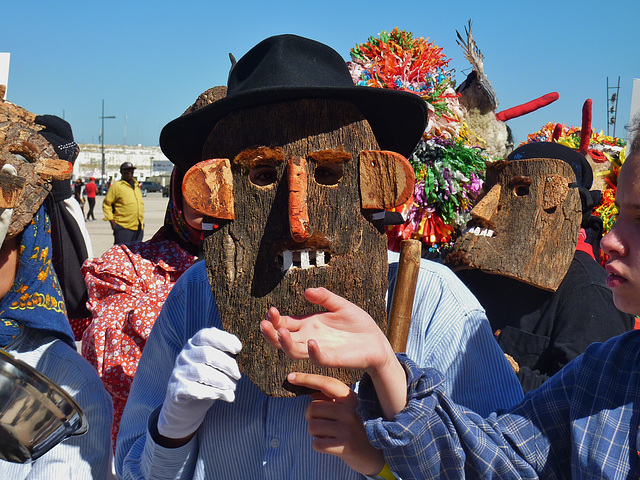Masks II
Leaving the Gardens
Sans Masque
Woman's toil
Man at work
P1010845
P1050599
Love
Man at work
DSCF2578
Man at Work - Silhouette
Flowers to Mikkeli
IMGP2576
DSCF5333
Family
Capela de S. Sebastião
Óbidos
DSCF1838
Sintra
Hunter . . .
DSCF1504
Mixed blessings.
IMG_0618
DSCF6251
IMG_9828
IMG_2268
DSCF7283
IMG_2269
DSCF8419
DSCF9204
IMG_2016
DSCF9720
IMG_9660
DSCF7959
DSCF9322
DSCF8876
See also...
Keywords
Authorizations, license
-
Visible by: Everyone -
All rights reserved
-
1 195 visits
Masks


A mask is an object normally worn on the face, typically for protection, disguise, performance, or entertainment. Masks have been used since antiquity for both ceremonial and practical purposes.
They are usually worn on the face, although they may also be positioned for effect elsewhere on the wearer's body. In parts of Australia, giant totem masks cover the body, whilst Inuit women use finger masks during storytelling and dancing.
The use of masks in rituals or ceremonies is a very ancient human practice across the world, although masks can also be worn for protection, in hunting, in sports, in feasts, or in wars – or simply used as ornamentation. Some ceremonial or decorative masks were not designed to be worn. Although the religious use of masks has waned, masks are used sometimes in drama therapy or psychotherapy.
The mask is normally a part of a costume that adorns the whole body and embodies a tradition important to the religious and/or social life of the community as whole or a particular group within the community. Masks are used almost universally and maintain their power and mystery both for their wearers and their audience.
(to be continued)
They are usually worn on the face, although they may also be positioned for effect elsewhere on the wearer's body. In parts of Australia, giant totem masks cover the body, whilst Inuit women use finger masks during storytelling and dancing.
The use of masks in rituals or ceremonies is a very ancient human practice across the world, although masks can also be worn for protection, in hunting, in sports, in feasts, or in wars – or simply used as ornamentation. Some ceremonial or decorative masks were not designed to be worn. Although the religious use of masks has waned, masks are used sometimes in drama therapy or psychotherapy.
The mask is normally a part of a costume that adorns the whole body and embodies a tradition important to the religious and/or social life of the community as whole or a particular group within the community. Masks are used almost universally and maintain their power and mystery both for their wearers and their audience.
(to be continued)
, Dimas Sequeira, Trudy Tuinstra, Bruno Suignard and 15 other people have particularly liked this photo
- Keyboard shortcuts:
Jump to top
RSS feed- Latest comments - Subscribe to the comment feeds of this photo
- ipernity © 2007-2025
- Help & Contact
|
Club news
|
About ipernity
|
History |
ipernity Club & Prices |
Guide of good conduct
Donate | Group guidelines | Privacy policy | Terms of use | Statutes | In memoria -
Facebook
Twitter

Admired in:
www.ipernity.com/group/tolerance
J. Gafarot club has replied to William Sutherland clubJ. Gafarot club has replied to beverleyJ. Gafarot club has replied to beverleyFor the Cure:
Think Pink!
Breast Cancer Awareness!
J. Gafarot club has replied to ctofcscoJ. Gafarot club has replied to J.Garcia clubCes masques sont spécialement effrayants ... et ont peut-être un sens particuliers ...?
Est-ce une fête qui se passe au Portugal ?
Bonne journée, José.
J. Gafarot club has replied to Christiane ♥.•*¨`*•✿Bonne journée pour toi.
J. Gafarot club has replied to RHH clubI assume it is 4 to 5 years old because it doesn't seem thick enough to be taken out normally. Perhaps it was a sick tree. For the the first "harvest" the tree must be 25 to 30 years old. After that you must wait 9 years between takes. There are about 2,200,000 hectares of cork forest worldwide; 34% in Portugal and 27% in Spain. Annual production is about 200,000 tons; 49.6% from Portugal, 30.5% from Spain, 5.8% from Morocco, 4.9% from Algeria, 3.5% from Tunisia, 3.1% Italy, and 2.6% from France. The cork is traditionally stripped from the trunks every nine years, with the first two harvests generally producing lower quality cork. The trees live for about 300 years.
Thank you Ron.
J. Gafarot club has replied to Jaap van 't Veen clubIf you cannot see your VPU award, but want to? Please click here
J. Gafarot club has replied to Dimas Sequeira clubSign-in to write a comment.